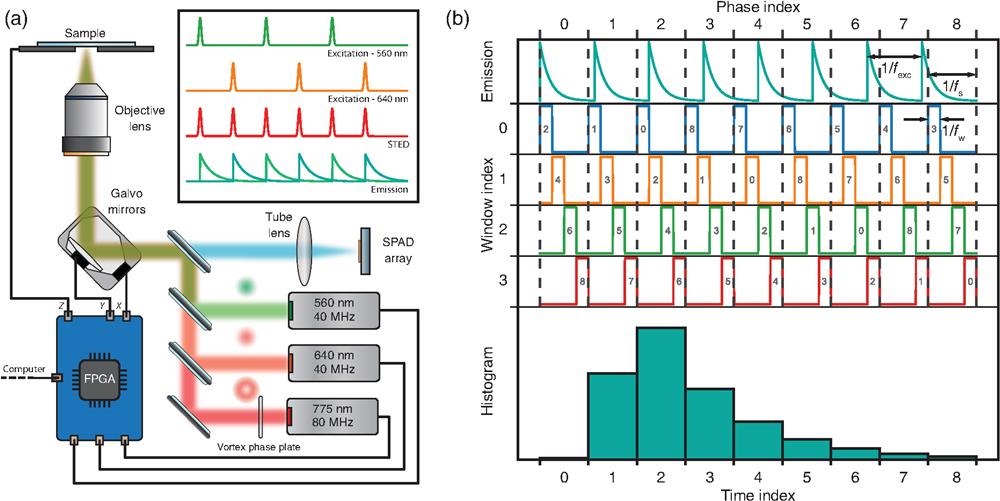Giorgio Tortarolo, Alessandro Zunino, Simonluca Piazza, Mattia Donato, Sabrina Zappone, Agnieszka Pierzyńska-Mach, Marco Castello, Giuseppe Vicidomini, "Compact and effective photon-resolved image scanning microscope," Adv. Photon. 6, 016003 (2024)
Search by keywords or author
- Advanced Photonics
- Vol. 6, Issue 1, 016003 (2024)

Fig. 1. Setup and acquisition scheme. (a) Sketch of the STED-ISM custom microscope. The FPGA board controls two excitation lasers, a depletion laser, a couple of galvanometric mirrors, and a piezo-electric-controlled stage. The same FPGA board reads the output of each channel of the SPAD array detector. (b) Working principle of the heterodyne acquisition. The lifetime decay is sampled along multiple excitation periods using a detuned sampling frequency. The sampling accumulates a delay in each period, enabling data collection at different time points. Each sampling period is subsampled by short windows, boosting the temporal resolution.

Fig. 2. Validation of the DFD architecture. (a) Calibration procedure. The measured phasor is shifted and rescaled by the IRF calibration values. Additionally, each histogram is phase-shifted by the value provided by the trigger reference signal. Top, calibration of Alexa 594; bottom, calibration of Rhodamine 101. (b) Measured lifetime of an autofluorescent plastic slide as a function of the detected photon flux and of the hold-off time of the SPAD. The reported values are the saturation thresholds (in units of megacounts/s), defined as the flux at which lifetime estimation deteriorates by a factor larger than 3%. (c) Lifetime of a fluorescein solution at increasing concentration of a quencher, potassium iodide. We depict with the same colors the exponential curves and the corresponding phasors.
Fig. 3. FLISM imaging. (a) Alpha-tubulin stained with ATTO 647N in fixed HeLa cells. (b) Nuclear pore complexes stained with Abberior STAR 580 in fixed HeLa cells. (c) Live HeLa cell labeled with the CellBrite® NIR 680 cytoplasmic membrane dye. The displayed frames are captured at
Fig. 4. Time-resolved acquisition for multicolor ISM imaging. (a) ISM imaging of different species, reported by two dyes with similar “spectra” but different fluorescence lifetimes. (b) Pulse-interleaving ISM imaging of different species with overlapping absorption spectrum and identical lifetime. Left, schematic diagrams of (top) the absorption/emission spectra of fluorophores 1 (magenta) and 2 (green), and (bottom) of the detected signal over time. The excitation lines are also represented. Right, phasor representation of (top) two measurements obtained with only one species labeled at a time, and (bottom) of the measurement with both species labeled. Left image, raw open confocal image. Central image, open confocal result obtained by (a) segmenting the phasor space in two regions, related to the first and the second fluorophores or (b) by temporal gating of the detected signal in two temporal channels, related to the first and the second excitation events. Right image, open confocal and ISM results obtained by phasor separation.
Fig. 5. SPLIT-STED-ISM. (a) Side-by-side comparison of raw STED imaging and SPLIT-STED-ISM imaging of the cytoskeleton network. The insets show magnified details of the network. The incomplete depletion background is also visualized (bottom inset, right corner). (b) Multispecies SPLIT-STED-ISM imaging (green, Golgi apparatus; red, nuclear pore complex protein, NPC). Pulse-interleaving excitation and time-resolved detection enable the separation of two color channels—one per each fluorophore—and to apply SPLIT to the NPC channel. The upper corner shows the raw STED image (blue), while the lower corner shows the final multi-color SPLIT-STED-ISM image.

Set citation alerts for the article
Please enter your email address



